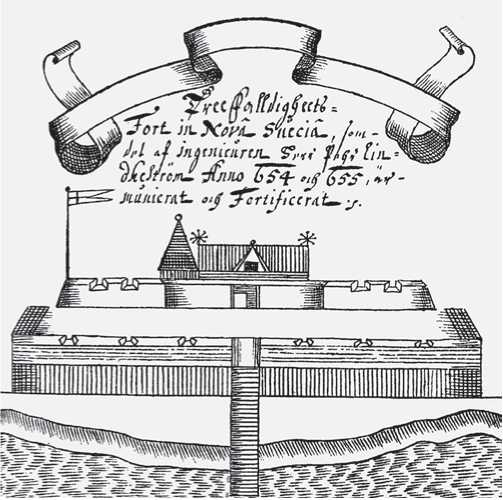The Swedish colony of Nya Sverige (New Sweden) on the Delaware River was the smallest of all European colonies in North America, with a population of only about 200 for most of its short duration (1638-55), but New Sweden was significant beyond its size and longitude in establishing patterns of population diversity and Indian relations unknown in most of the other colonies. The population included Swedes, Finns, Dutch, Germans, Poles, and English. From the start the colony’s leaders purchased lands from the local Lenape and Susquehannock Indians rather than claiming land rights by “first discovery,” as the Dutch and English had.
Peter Minuit led the first Swedish expedition and established Fort Christiana (now Wilmington, Delaware) in 1638 as an outpost of the New Sweden Company, a private company of Dutch and Swedish investors who expected to profit from trade in furs and TOBACCO. By 1641 the Swedish Crown had bought out the Dutch investors. The colony began as a military and trading post but evolved into a successful trading and agricultural settlement under the governorship of Johan Printz (1643-53). Printz’s daughter, Armgard, one of the first Swedish women to arrive in the colony, married her father’s successor, Johan Papegoja, and achieved notoriety when she refused to accompany her husband back to Sweden.
Over an 18-year period 12 expeditions set out from Sweden for New Sweden; two of these never made it to the colony (one was seized by the Dutch, the other by the Spanish). Most immigrants were from areas then under the control of the Swedish Crown, which encompassed Finland and, during the Thirty Years’ War (1618-48), extended over much of Poland and Prussia as well as some German towns. The earliest immigrants were mostly soldiers and other single men; some were convicted criminals who had chosen military service in New Sweden instead of death by hanging. Subsequent settlers included nobles, clergy, merchants, civil servants, peasants, and laborers. The final expedition in 1656 included 350 women, men, and children, most of them Finns or Swedes who had lived in

This woodcut shows Fort Christiana, the Swedes' main outpost on the Delaware River. (Library of Congress)
Finland. Even before the ships sailed, New Sweden had surrendered to the Dutch, who controlled the region until the English took control in 1664 and again in 1674. After William Penn became proprietor in 1681, he relied on Swedish traders and interpreters in his negotiations with the Lenape and other Indians. In 1697 the Swedish and Finnish population in the region numbered at least 1,200; many continued to speak the languages of their ancestors until well into the 18th century.
Further reading: C. A. Weslager, New Sweden on the Delaware, 1638-1655 (Wilmington, Del.: Middle Atlantic Press, 1988).
—Alison Duncan Hirsch




 World History
World History









